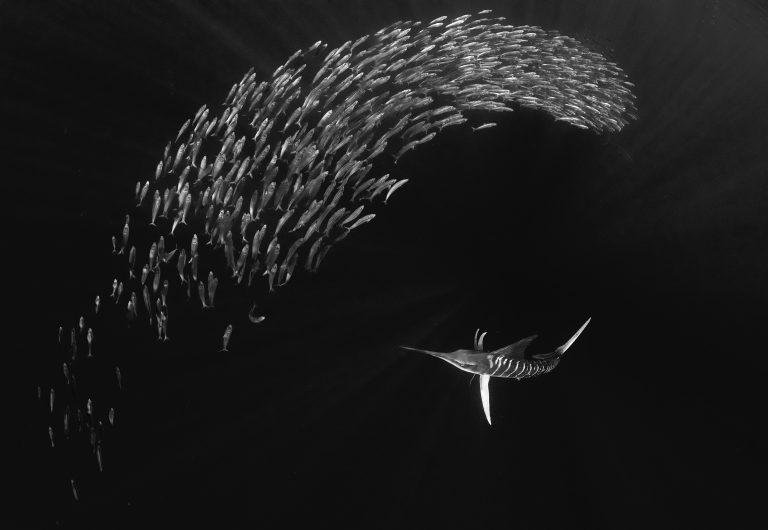
The Sword of Santiago

In Ernest Hemmingway’s classic novel, The Old Man and the Sea, Santiago is the grizzled old fisherman whose suffering and torment of enduring eighty-four days without catching a fish, is spectacularly ended by his hooking of a huge marlin.
For days he drifts further and further from home as he fights the unfatiguing fish.
Finally, he subdues his quarry and secures the trophy alongside his boat for the arduous journey back to shore. During the night, sharks attack and the marlin is destroyed. All that remains is the marlin’s head as evidence of his epic battle.
It is no surprise that Hemmingway chose the gladiator-like marlin as Santiago’s opponent, for there is a no more celebrated and worthy game fish in all of the ocean. Built for speed with a huge forked tail, a muscled streamlined body, tiny rudders, foils and stabilisers all rounded off with a rapier-like bill, and you have a strikingly formidable hunter.
As a photographer, you dream of photographing one of these great fish.
The marlin embody so many characteristics and attributes that make them alluring subjects and with their modern, architectural design, they offer an opportunity to artistically create a work that celebrates both form and function.
I must have done at least 500 drops into the ocean on this expedition off the coast of Mexico.
Each time we spotted activity on the surface by way of feeding frigate birds or tell-tale predatory splashes and slashes, I dived in hoping to see action, and most times I did. Sometimes fleeting, sometimes lengthy. The action varied, but each occasion was memorable.
As the marlin charged into the bait balls of sardine, pursuing and corralling, their excitement was evident by the way their colours lit up, their stripes becoming more emboldened each time.
In turn, the sardine would murmurate around them in wonderful gyrations, wisps and vestiges.
It was in this marine monologue of movement and survival that I saw the opportunity to create a work that married both elements of predatory prowess and artistry.
In the short moment the sardines formed into what appeared to be a breaking wave around the marlin, I knew I had a very special opportunity to create an image that paid homage to both natural history and living art.
All great warriors have an Achilles heel, sometimes by design, and sometimes by circumstance.
Like all predators, the marlin is dependent on prey.
Ironically, as with Goliath, it is the smaller David in the form of the sardine that will ultimately fell this most iconic of marine giants.
Ecosystems are reliant on predators to keep balance, but it is the prey that keeps the whole system going. In South Western Mexico along the Pacific seaboard, sardines are being fished at unsustainable levels.
Consider that along the South African and Namibian coast, once one of the most productive waters in the world, multinational fleets plundered the stocks of sardine and anchovy so heavily that the supposedly inexhaustible supply crashed, and so with it the entire eco system.
All species from whales and sharks to seals, gamefish and sea birds have been impacted.
Today billions of jellyfish and jelly like salps have stepped into the ecological void left behind by the huge shoals of bait fish, and ironically, now by sheer mass, it is these ancient gelatinous predators that consume all the fish larvae that previously would have become adult fish.
Sadly, this situation seems to be in the offing off Mexico where boats laden to their gunnels plunder the stocks, both inside and outside of protected areas.
When the inevitable collapse of the bait stocks takes place, the traditional line fishermen, the great whales, the super sharks and the whole predatory ensemble, inclusive of the mighty marlin, will be a thing of the past.
Having had the privilege and wonder of seeing this noble and magnificent gamefish brandishing it’s sword in the face of an uncertain future, I could not but think of Santiago whose defiance of his circumstance led him once more into a sea of adversity.
He, and the marlin, are both stubbornly resolute that feast and famine sit on different sides of the sword, and it helps not to question tomorrow, but rather wield your sword today like tomorrow may never come.
Available Sizes
Exhibition: 173cm x 119cm (68″ x 46.8″) – AED 54,600
Large: 146cm x 101 cm (57.5″ x 40″) – AED 42,840
Classic: 118cm x 81.5cm (46.5″ x 32″) – AED 35,994
Available Editions
Exhibition: 12
Large: 12
Classic: 12

